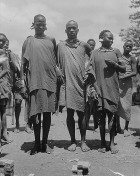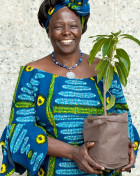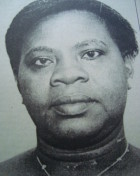Queen Nzinga of Angola is one of the most celebrated African women to resist European colonisation. Nzinga Mbande led four decades (1620s to 1660s) of warfare against the Portuguese in Angola. Her legacy is a controversial and paradoxical one, as she was a proto-nationalist resistance leader, a devout Christian and Portuguese ally, a superb but ruthless Mbande politician and a vicious slave trader. Despite these contradictions, what remains undisputed is Nzinga’s skill as a negotiator and military strategist: she was directly responsible for limiting the Portuguese colony at Luanda to a few square miles.[1]
Ana de Sousa Nzinga was born in 1581 in Kabasa, the capital of the Kingdom of Ndongo (now Angola), which was ruled by a people called ngolas. In 1571, a royal order from Lisbon declared that the kingdom of Ndongo be subjected and captured. The Portuguese had already converted the Kongo, a neighbouring people, and were after ‘black ivory’, that is slaves in Angola.[2] Nzinga’s father, Ngola Karensi, distrusted the European expansion and banned missionaries from his kingdom. This action resulted in a war of resistance that lasted 40 years.
Nzinga, an Amazon and warrior, used to dress in men’s clothing and was considered to be the best politician in the country. However, her strategies angered her brother, Mani aNgola, who became ruler after their father’s death. In his anger, Nzinga’s brother sterilised her and killed her only son. However, after suffering many defeats by the Portuguese, he later begged his sister for help, and Nzinga agreed to aid him to keep her people from being enslaved. As she spoke Portuguese, she was sent to negotiate a treaty, which was signed but not honoured.[3]
There are conflicting accounts as to how Nzinga ascended to leadership. One account shows that after her negotiations with the Portuguese, Nzinga returned home, jailed her brother, declared herself ngola and issued her first orders.[4] Another account notes that in 1624, Nzinga succeeded to the throne of Ndongo after her brother died under what some deem suspicious circumstances.[5] After Nzinga had claimed the title of ngola, she retreated eastward to Matamba, as a puppet ngola had been put in her brother’s place by the Portuguese after his death.
Nzinga had three main policy objectives. She wanted to stop the war between the Portuguese and her people, which was devastating the Luanda plateau. She wanted to obtain from the Portuguese the diplomatic recognition that had been accorded to the Kongo. And she wanted to establish a regular and profitable trading relationship between Luanda and Europeans. In the 1630s and 1640s, she forged an alliance with Dutch slave traders and used her wealth to consolidate her position. She also overcame traditional Mbande resistance to women in politics, employing Mbande refugees (runaway slaves) and others as mercenaries against local resistance where necessary. After continuous war against the Portuguese, she concluded a treaty with them that largely fulfilled her initial goals, and her policy continued successfully until her death.
Resisting colonisation
Queen Nzinga’s lived and reigned in a time of colonial conquest and conflict between indigenous groups. The Portuguese had become preoccupied with the Ndongo Kingdom as a source of slaves and with expanding the colony of Angola.
Early resistance to the colonial onslaught was offered by the Luanda, Matamba and Kasanje kingdoms, which had acquired strong positions through trading slaves for goods from the Americas. The Portuguese did not gain any real control during these initial attempts to govern their proclaimed colony, but did manage to establish a number of forts and other footholds to the east of Luanda. In an attempt to find easier routes to the interior and slaves, the Portuguese also moved southward, where a settlement had been established in Benguela in 1617. But there they met considerable resistance in the highlands from various Ovimbundu kingdoms. Slaves were mainly supplied by competing warlords from the Wambu, Mbailundu and other Ovimbundu kingdoms. The slaves were sold for firearms and other imports, which preserved the power of the victors.[6]
It was at this time that Nzinga was sent to Luanda in 1622 to discuss peace terms with the Portuguese governor there. As a necessary preliminary (which for a time won her Portuguese goodwill), she had herself baptized Dona Ana de Souza.[7] In exchange for temporarily opening her country to missionaries and especially to the Portuguese slave trade, she managed to have a fortress that was located too close to her lands evacuated and certain chiefs whom the Portuguese had made their vassals freed.[8] Most importantly, she won recognition of her dominion over Ndongo. The freed chiefs were probably little inclined to accept this, given the double handicap of Nzinga’s questionable ascendance to political power and her gender.
In 1623, disappointed with the Portuguese, Nzinga broke with Christianity and allied herself with the Jaga, a marginal group of warriors recently arrived from the southern Kwanza River plateaus. She also gave asylum to all fugitive slaves from Portuguese-controlled territory and induced kimbares (African soldiers) trained by the Portuguese to join her army by promising them land and rewards. She led her men to infiltrate the Portuguese army to incite the Africans within it to desert.
Thus by the end of 1624, Nzinga was slowly gaining the military advantage. In 1625, she finally incited one vassal chief after another to rebel against the Portuguese and was then told that war would result if she did not return the soldiers and the fugitive slaves.[9] She categorically refused.[10] By now she had been able to increase her forces sufficiently and obtain sufficient arms to plunge the kingdom into open warfare.
The Portuguese wanted to expel Nzinga and her followers and replace her with a monarch who would be subservient to their needs and wishes. Aided by perhaps most of the Mbande, the Portuguese managed to rout her, and this led to a protracted guerrilla war. They were eventually able to force Nzinga off her throne and replace her with a puppet ruler. Nzinga went into exile and continued to work to convince her followers to destroy the usurper’s rule and to expel the Portuguese who maintained him in power.
The Jaga’s tactics helped to foil many Portuguese attempts to capture Nzinga dead or alive. In 1629, she consolidated her power as a tembanza (a Jaga title reserved for powerful women) by arranging a ritual marriage (actually a political alliance) with the Jaga’s chief, the Kasanje.[11] She later broke with the Jaga when they allied themselves with the Portuguese and came to pillage her capital.
Nzinga decided to conquer the kingdom of Matamba to the northeast. Matamba was one of the few places in the southern Konga and northern Kimbundu that had a history of women ruling. It was also the principal African slave-trading state in the Luanda region. Once in control there, Nzinga worked to develop strong ties with the Dutch to help her against the Portuguese, as well as for commercial and political reasons. Her goal was to remove the Portuguese from Angola altogether and have the Dutch as the European trading power on the coast.
Over the next few years, using a combination of ruthlessness and cleverness, Queen Nzinga was able to consolidate power in the Kimbundu territory of Ndongo and Matamba. Although often perceived as an outsider by Africans as well as Europeans because of her gender, she was able to manipulate her enemies and gather other outsiders around her to gain support to rule effectively. At times, she supported the slave trade from Africa to the Americas, but she also sometimes protected escaped slaves, in exchange for their loyalty. Matamba dominated the whole Kimbundu region, and after successfully fighting the Portuguese, Nzinga turned on her Dutch allies and defeated them as well. She then made a new alliance with the Portuguese, so that she could export the slaves she had captured in war or received from her vassals. In 1656, she signed a peace treaty with the Portuguese governor of Angola and reconverted to Catholicism.[12]
Nzinga was able to keep the peace until her death at approximately 81 in 1663. She died a Catholic, and her deathbed was surrounded by the missionary advisers she had come to value in the last eight years of her life.
Her legacy
Through her clever manipulations of the Portuguese, the Imbangala and the Dutch, Nzinga was able to dominate Kimbundu politics for 40 years. Her legacy is immense, if contradictory.
First, she was a leader who could inspire her people to resist the Europeans. Second, she had unusual strength, and her role as a warrior and an anti-colonialist is an excellent example of the commitment of African women to values of self-reliance and survival. From the period of Nzinga’s leadership to the present, African women have been at the forefront of resisting the militarism and the murderous tendencies of colonial economic relations and of social structures that privileged masculinity and violence. As to Nzinga’s role as a slave trader, many either choose not to believe it or to simply accept it as part of her legacy.[13] One perspective on Nzinga’s contradictions is that her quest to preserve the humanity of African people required her to develop a flexible and strategic identity.[14]
Queen Nzinga’s record as a military leader, diplomat, spiritual leader and mother belie any simplistic conception of gender identities in African societies. She has a special position in Angolan history and is seen as an important root of African nationalism both because of her resistance to colonial rule and because of her success in breaking the regional power of the old ethnic provinces.
—
Footnotes:
[1] Collelo, T. (1991). Angola: A country study. Washington: U.S. G.P.O.
[2] Smith, C. A. (2005). Market women: Black women entrepreneur—past, present, and future. Westport, CT: Praeger Publishers.
[3] Smith, C. A. (2005). Market women.
[4] Ibid.
[5] Levin, C., Barrett-Graves, D., Carney, J. E., Spellman, W. M., Kennedy, G., & Witham, S. (2000). Extraordinary women of the medieval and Renaissance world: A biographical dictionary. Westport, CT: Greenwood Press.
[6] Coquery-Vidrovitch, C., & Raps, B. G. (1997). African women.
[7] Ibid.
[8] Levin, C. et al. (2000). Extraordinary women.
[9] Vansina, J. (1996). Kingdoms of the Savanna. Madison, WI: University of Wisconsin Press.
[10] Ibid.
[11] Coquery-Vidrovitch, C. & Raps, B. G. (1997). African women.
[12] Levin, C. et al. (2000). Extraordinary women.
[13] Collelo, T. (1991). Angola.
[14] Palmberg, M. (1999). National identity and democracy in Africa. Uppsala, Sweden: Nordic Africa Institute.





